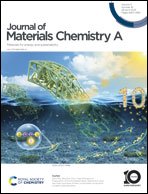An extended π-conjugated organosulfide-based cathode for highly reversible sodium metal batteries†
Abstract
Na-organic batteries are a promising candidate for grid-scale energy storage due to the abundance of Na and absence of transition metal elements. However, the shuttle effect of soluble redox-active organics induces low coulombic efficiency and fast capacity decay, especially collocated with the highly reactive Na metal anode. Herein, we uncover that 2,3,6,7,10,11-triphenylenehexathiol (THT) with the largest conjugated plane and 18π electrons has low binding energy with ether solvent. Therefore, THT has a low solubility of <0.02 g L−1 and thus the shuttle effect is evidently mitigated. Furthermore, the trace amounts of dissolved THT-based redox mediators can be well confined by the Nafion membrane due to the large molecular size and the Na-THT battery achieves a reversible capacity of ca. 190 mA h g−1 with stable cycling over 700 times. Meanwhile, the energy density of the Na-THT battery with the thin-film Na metal anode remains at 113.8 W h kg−1 at the 400th cycle. The work demonstrates the advantages and prospects of large conjugated organic cathodes in Na-organic batteries for large-scale energy storage.

- This article is part of the themed collection: Journal of Materials Chemistry A HOT Papers


 Please wait while we load your content...
Please wait while we load your content...